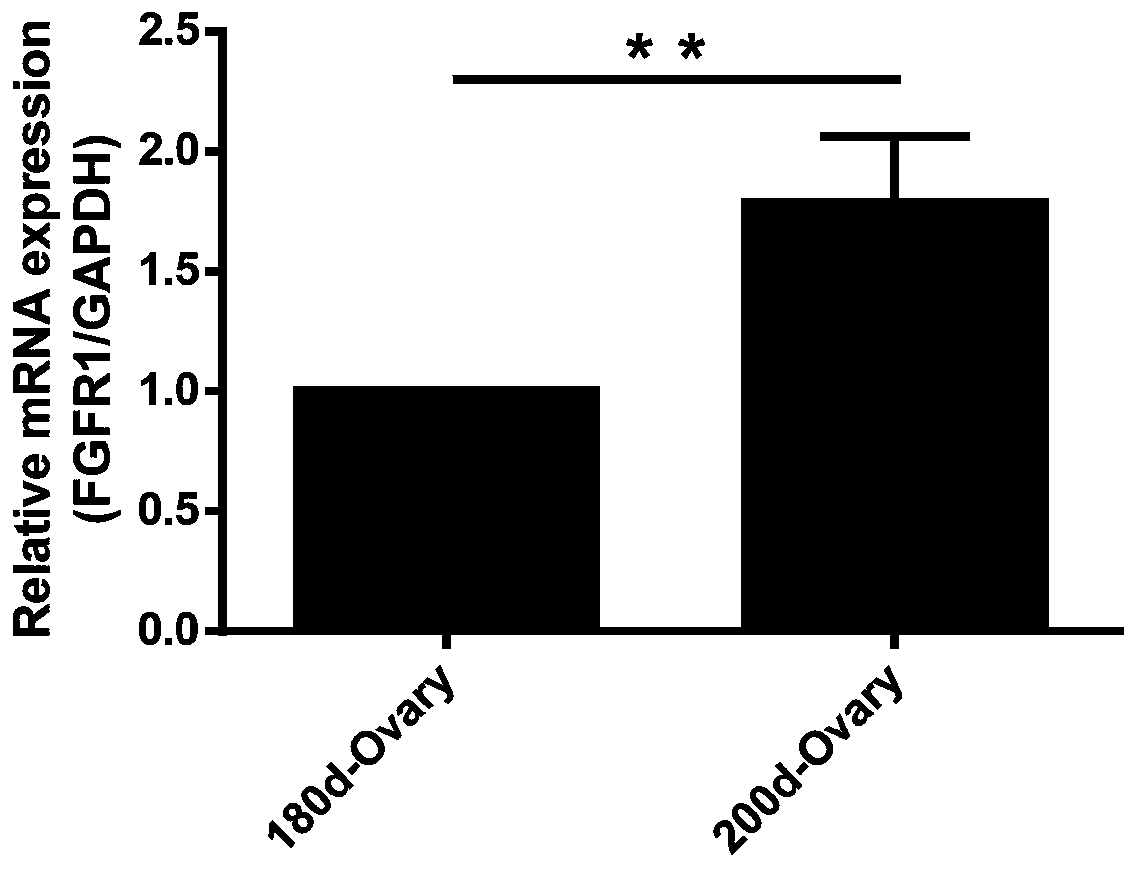Application of FGFR1 genes to granulosa cells of sows
A technology of granulosa cells and genes, applied in the application field of FGFR1 gene in porcine ovary granulosa cells
- Summary
- Abstract
- Description
- Claims
- Application Information
AI Technical Summary
Problems solved by technology
Method used
Image
Examples
Embodiment 1
[0033] Example 1 Construction of FGFR1 Gene Overexpression Vector
[0034] BioEdit software analysis found that the CDS region sequence of the FGFR1 gene has no restriction endonuclease sites BamH I and Xba I, but the pcDNA3.1 vector (purchased from Invitrogen, Cat. No. V79020) has BamH I and Xba I restriction sites point. The primer premier 5.0 software designed the primers for the CDS region of the FGFR1 gene, and the upstream and downstream primers were added with BamH I and Xba I restriction site sequences. Using the cDNA of porcine ovary granulosa cells as a template, the target fragment was amplified by PCR, purified and recovered, double enzyme digested, connected to the pcDNA3.1 vector, transformed, screened, sequenced and identified correctly, and then the endotoxin-free plasmid was extracted (a small amount of endotoxin-free plasmid The extraction kit was purchased from Magen Company) and named pcDNA3.1-FGFR1.
Embodiment 2
[0035] The cultivation of embodiment 2 ovarian granulosa cells
[0036] (1) Put the ovarian tissue collected in the slaughterhouse into PBS or normal saline containing 1% double antibody, put it on ice and bring it back to the laboratory quickly;
[0037] (2) Wash the collected ovaries three times with PBS or normal saline (containing 1% double antibody) in a sterile culture room, then quickly transfer them to the ultra-clean workbench, and use a 1 mL sterile disposable syringe to shallowly insert the antral follicles of the ovary absorb follicular fluid;
[0038] (3) Place the aspirated follicle fluid in a centrifuge tube containing an appropriate amount of DMEM, and centrifuge at room temperature for 5 min at 800 rpm;
[0039] (4) Discard the supernatant, then resuspend in DMEM, centrifuge, and wash the cells twice; prepare DMEM complete medium: 89% high-glucose DMEM+10% FBS+1% double antibody;
[0040] (5) Resuspend cells with complete medium, inoculate in 75mL culture fl...
Embodiment 3
[0042] Example 3 Inoculation and transfection of ovarian granulosa cells
[0043] (1) When the confluence of granulosa cells reaches about 90%, the medium is discarded, and the cells are washed 3 times with preheated PBS;
[0044] (2) Add 0.25% trypsin for digestion, put it in the incubator for about 3 minutes, observe under the microscope until most of the cells float up, immediately add an equal amount of stop solution (complete medium) to stop the digestion;
[0045] (3) PBS was washed twice, and centrifuged at 800 rpm for 5 minutes;
[0046] (4) Gently resuspend the cell pellet with complete medium, evenly distribute into each well, supplement the volume with complete medium, shake gently, and culture in the incubator;
[0047] (5) About 24 hours, observe the state of granulosa cells, and prepare for transfection when the confluence of the cells reaches about 70-90%;
[0048] (6) transfection method is by Invitrogen company's 3000 kit instructions were carried out; each ...
PUM
| Property | Measurement | Unit |
|---|---|---|
| Diameter | aaaaa | aaaaa |
Abstract
Description
Claims
Application Information
 Login to View More
Login to View More - R&D
- Intellectual Property
- Life Sciences
- Materials
- Tech Scout
- Unparalleled Data Quality
- Higher Quality Content
- 60% Fewer Hallucinations
Browse by: Latest US Patents, China's latest patents, Technical Efficacy Thesaurus, Application Domain, Technology Topic, Popular Technical Reports.
© 2025 PatSnap. All rights reserved.Legal|Privacy policy|Modern Slavery Act Transparency Statement|Sitemap|About US| Contact US: help@patsnap.com



